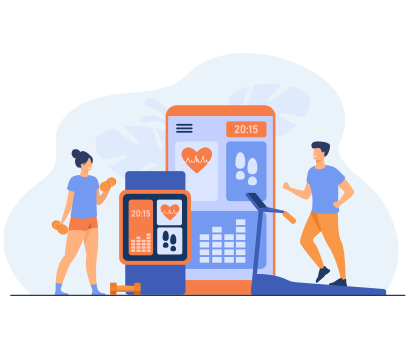Some good news for you!
The fitness industry is reinventing itself. Virtual fitness, on-demand streaming video, meditation apps, nutrition apps, etc. are being significantly being adopted by customers.
The flaws of sedentary lifestyle has made people aware of the health issues caused. People are adopting a healthy lifestyle by eating clean, and counting their daily calorie intake. These reasons are rising the demand for diet and nutrition apps.
Therefore, we think this is the best time to help you keep your business going. We have formed a roadmap for how to build diet and nutrition guide app. If you follow the tips, by the end, you will have enough information to create diet & nutrition application.
Let’s begin! We will cover:
- 5 Ideas to Create Diet & Nutrition App That Work
- Who’s My Audience? – Typical Users of Diet & Nutrition App
- Features – A Backbone of Your Diet & Nutrition App
- Tech Tools to Build Diet & Nutrition App
- AI to Automate Nutrition Planning
- How Much Does It Cost to Build a Diet & Nutrition App?
- Make Profit with Nutrition Guide App
- Over to You
5 Ideas to Create Diet & Nutrition App That Work
There are thousands of diet & nutrition apps available on Google play store and Apple Store. Each one of these apps cater to a different audience and have different functionalities. Here’s a breakdown of 7 app types that you can take inspiration from before you create diet & nutrition app.
Idea 1: Calorie Tracker
Counting calories is the first step towards a healthy lifestyle. Therefore, everywhere you will find packaged food labeled with calories, hundreds of articles on what to eat and what to avoid. However, counting calories is not easy. An extra cup of sugary tea or mindless snacking while watching TV can impair a healthy eating regime.
Calorie counter apps are a great tool to keep track of calories daily. Both Android and iPhone calorie counter apps work in a simple way – the user logs in information about the food they eat or the activities they do, and the app calculates the calories consumed and burnt. Calorie counter apps analyze the user data and then send personalized dietary recommendations.
One of the biggest players in the industry, MyFitnessPal occupies first place in the fitness category in the Apple store. This iPhone calorie counter app counts calories, water consumed, and tracks user activity.
It has a wonderful set of features:
- 6+ million food database
- Barcode Scanner
- Food journal
- Custom calorie goal
- Integration with a fitness tracker
- Recipe importer, and more.
The app works on a freemium model – earning through premium memberships and ad revenue.
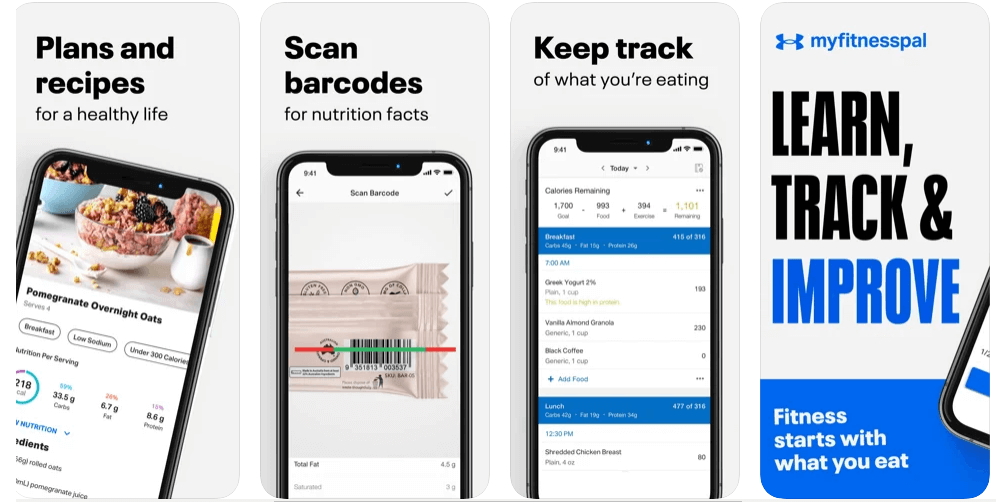
Idea 2: Meal Planning App
One of the hardest parts of living a healthy lifestyle is diet. Creating meal plans is not an easy task in a busy life. And that’s why people need a meal planning app that will help them customize their meals as per the diet type.
Eat This Much analyzes user data to generate a detailed meal plan. Users can browse recipes, and add their own. If the user signs up for a premium account, the app generates a week of meal plans and sends them to the user with a grocery list via email.
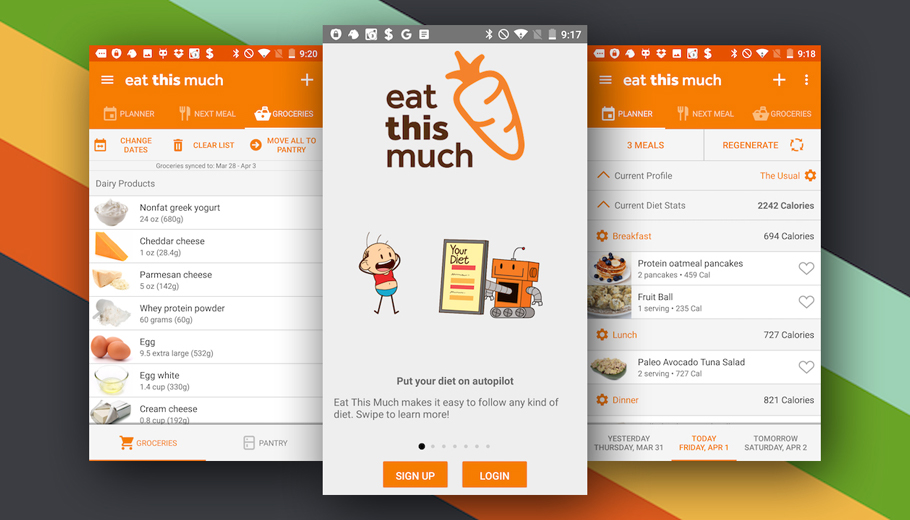
Idea 3: Vegan/Vegetarian Nutrition Guide App
You will find the word vegan on the internet more than ever before. Nearly 8% of the world population identifies as a vegan. A vegan app gives all the necessary information on the go. It provides plant-based recipes, helps find vegan food in town, track nutrition, and more.
Gonutss
Featured on PETA, this app works as a vegan interpreter. Gonutss includes hundreds of vegan products, recipes, and raw materials. Some of its features are –
- Search for vegan alternatives
- Veganpedia (to learn about vegan ingredients)
- Baking calculator
- Protein calculator
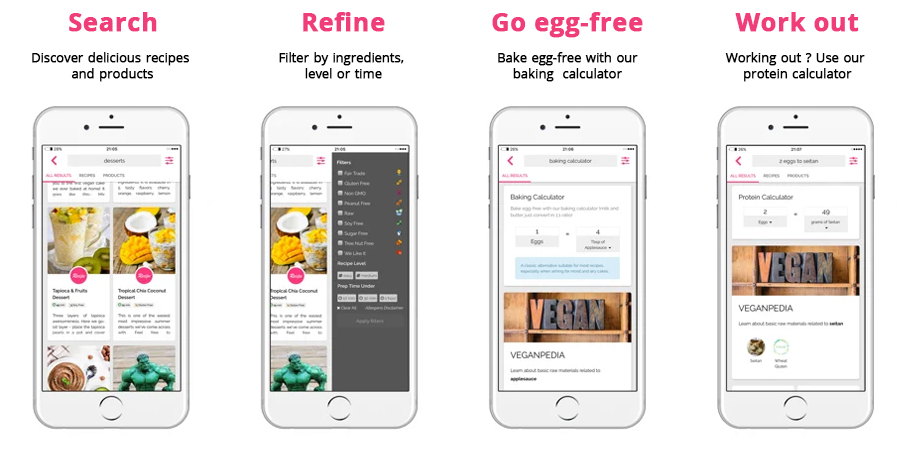
Idea 4: Diabetes Nutrition Guide App
While there are doctors who provide personalized nutrition plans for diabetics. But an app will help patients monitor their health 24/7. Diabetes apps offer a wide range of features that include food monitoring, tracking medication or glucose data, live chat between patients and health professionals, and more.
Glucose Buddy, meant for people with type 1, and type 2 diabetes lets them log blood glucose level, medication, carb intake, and more.
Functionality
- 12-Week Diabetes Education Plan featuring 5-minute lessons
- Meal IQ that helps make better food choices
- Integrates with Apple Health App
- meal data and blood glucose analysis through graphs
- Automatic cardio activity tracking
- Export of medical data to a PDF
The app follows a subscription-based model, and the user can avail additional features by subscribing to the premium plan. Here they get an ad-free experience and in-depth report analysis.
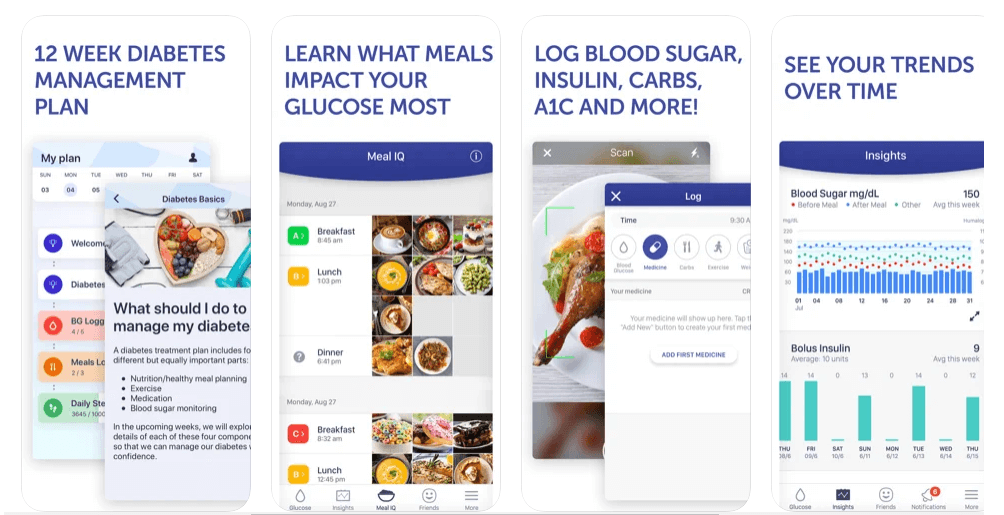
Idea 5: Pregnancy Nutrition Guide App
Pregnancy is a phase that needs constant monitoring. Mom-to-be has to follow a strict diet and monitor her health. That’s where these apps come in handy. Apart from helping them with diet plans, these apps enable them to track the baby’s growth, choose the right food, and learn safe workouts.
The app has a variety of interactive tools to help users navigate pregnancy. There’s more. It helps plan healthy menus, teaches how to welcome a newborn, decodes pregnancy symptoms, and more. Here’s a list of features –
- Baby registry
- Baby-names
- Planner for doctor’s visit
- Easy to cook recipes
- Daily pregnancy articles
Another popular app is Pregnancy App & Pregnancy Diet. This app works as a guide providing answers to weight gain, diet, trouble eating, morning sickness, and supplements during pregnancy.
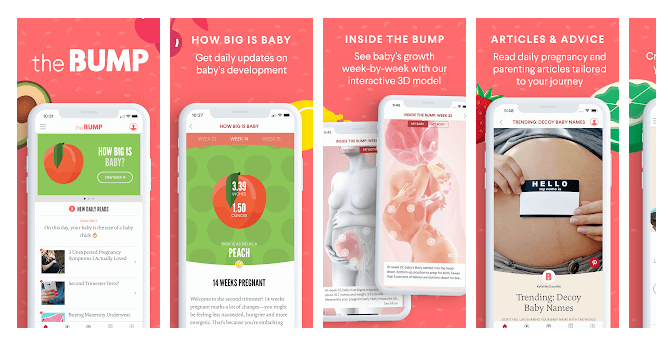
Have a unique idea to create a diet & nutrition app? We can help you with that!
Knowing different types of nutrition guide apps, by now, you might have formed an impression that diet applications are a strong market. Data Bridge Market Research analyses that the market is growing with a CAGR of 20.9% in the forecast period of 2020 to 2027 and is expected to reach USD 10,189.62 million by 2027.
No matter how great your idea is, you can work on it if you know whom to target. For starters, this can be a difficult job. To help you, we have formed this easy strategy to define your target market. Let’s find out more about it.
Who’s My Audience? – Typical Users of Diet & Nutrition App
Having a clear picture of your target audience helps you formulate your design, development, and marketing strategies. So, how will you define a target audience? Let’s find out.
At this stage, your belief might me – ‘I am going to help everyone get fit with my diet app’. Now, this is an incorrect approach. You need to narrow down to find a very specific audience. This will help you provide excellent solutions for them.
Begin by asking the following four questions –
Who I Want to Target
‘Who do I want to help?’. Do you want to serve diabetic patients in the age group 40-60? or would you like to target working professionals and help them with their meals? Think about different ideas and jot them down.
Tip – Here, for instance, instead of saying ‘I want a meal planning app for women’, go for let’s say a meal planning app for pregnant women. The first one is very broad; you want to go narrower.
What is My Audience’s Pain-point
Once you identify your potential market, it’s time to find out what problem the crowd faces. Remember, not every market has a pain point or a genuine problem to address.
For instance, somebody in their mid-40s will be genuinely interested in maintaining a healthy diet to avoid potential risks. On the other hand, someone in the mid-20s follows a fitness regime just for the gram.
You need to identify the pain point of your target market. Only then you will be able to deliver.
Where Does My Target Audience Hang Out
This information will help you target them with specific marketing strategies. Find out on which social media platforms they are most active; are there any fitness products they are buying?
You may wonder, wow will that help?
For example, if your target market is active on a specific Facebook page, you can target them with Facebook ads. By providing value, you are more likely to attract them.
How Can I Solve the Users’ Problem
Not that you know your target market, their problems, and where they hang out; it’s time to think about what you can do to solve their problem.
It could be anything – a recipe book, a one-on-one chat with the best dietitians, a customized diet plan, etc.
Here are a few stats to watch out for –
- The typical user of a diet app is young. As of 2017, 17% of 30- to 45-year-olds and 26% of 18- to 29-year-olds regularly use apps to track their diet and nutrition.
- Eating healthier was one of the New Year’s resolutions for 48% of Americans.
- Users download healthcare apps to monitor nutrition, track exercise, learn to work out, and reduce weight. (Source: Translational Behavioral Medicine).
Features – A Backbone of Your Diet & Nutrition App
Fasten your jogging shoes because we are going for a run. A run to explore how your diet application will work. We will understand this with a story.
For a while, just assume that your app is live. A user, Harry has downloaded your diet app from the Play Store/Apple Store, and he is about to begin his journey.
Registration and Profile
After downloading the diet application, the first thing Harry does is register himself. He fills in his personal details including name, email, age, gender, weight, height, and such.
He has certain allergies, and he is a vegan – he can add that too.
The app asks him to select different criteria such as does he want to track daily physical activity? Is he looking for a low-carb diet plan? Harry chooses the criteria that he expects the app to fulfill.
With this, he gets a user profile with all the necessary information.
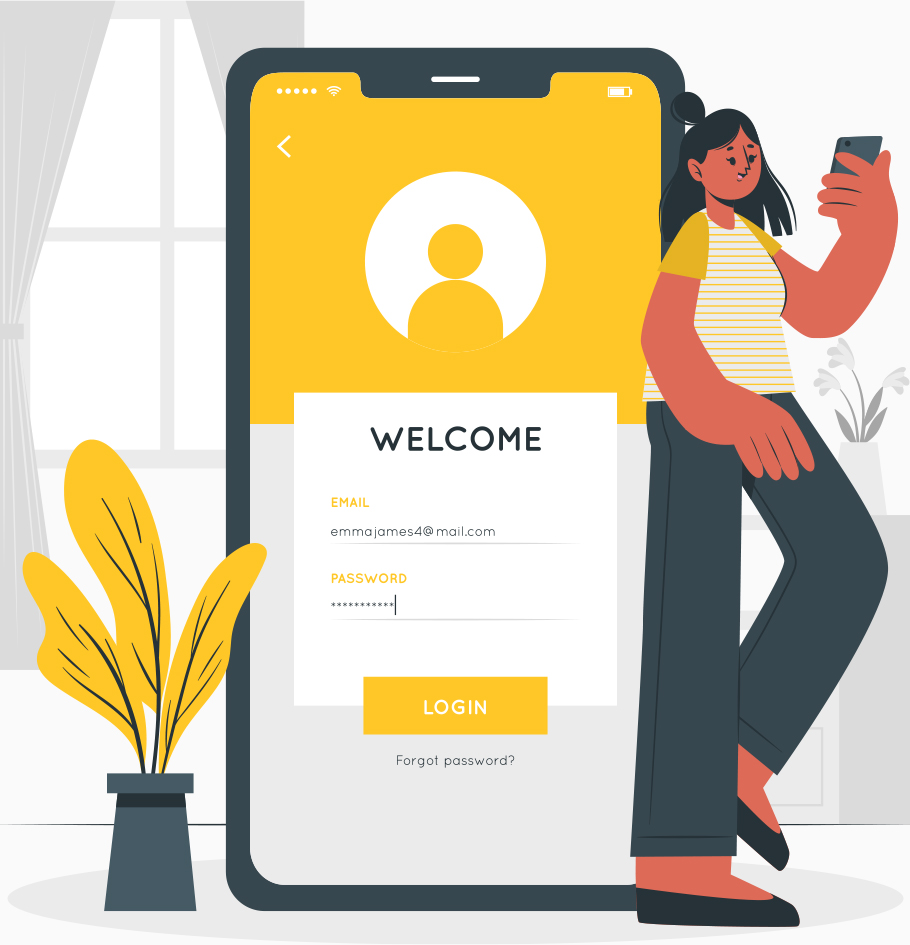
Tip for you – You will receive a crazy amount of personal data from the user profile. The data protection rules are too strict. Therefore, pay attention to security when working with collecting, and storing data.
For a better user experience, you can go with the social login option. Unlike traditional registration, it will save time as the person directly signs up using a social network.
Dashboard
Harry is a fitness enthusiast. He likes to track his calories a day in and day out. He even wants to keep checking if he drinks enough water. That’s where the dashboard comes into the picture. From diet tips to Harry’s progress, it tracks everything – carbs, fat, water intake, protein; you name it and the dashboard will tell you. How does the dashboard get this data? Daily, harry writes down what he eats using the food logging feature.

Push Notifications
During registration, Harry had permitted the app to send him notifications on every progress he makes. Moreover, if he forgets to drink the required amount of water, the app sends him reminders as well. Harry loves this feature. It keeps him motivated, engaged, and he likes the personalized experience.

Tip for you – As much as users appreciate customized notifications, they will frown if you send notifications at a deadly hour or if you send them too often. Worst scenario, they will block you. And that’s bad luck!
Integration with wearables
Harry not only wants to know how many calories he consumed but also how many he burned. Luckily, the diet app can satisfy him because it is integrated with Harry’s wearable device. With the help of the tracker support, he can get information about activities like cycling, and jogging, and other health data such as blood pressure, and heart rate.

Tip for you – You might consider including popular trackers like Apple Watch, or Fitbit. But the market for wearables is huge. Therefore, we recommend considering as many fitness trackers as possible. To integrate your diet app with wearables, there are APIs available which will discuss later in the blog.
Diet Plan
Stay at home has messed up Harry’s food habits. He is now actively looking for ways to eat clean. Here’s where the diet plan comes to the rescue. It includes personalized meal suggestions and nutrition tips.
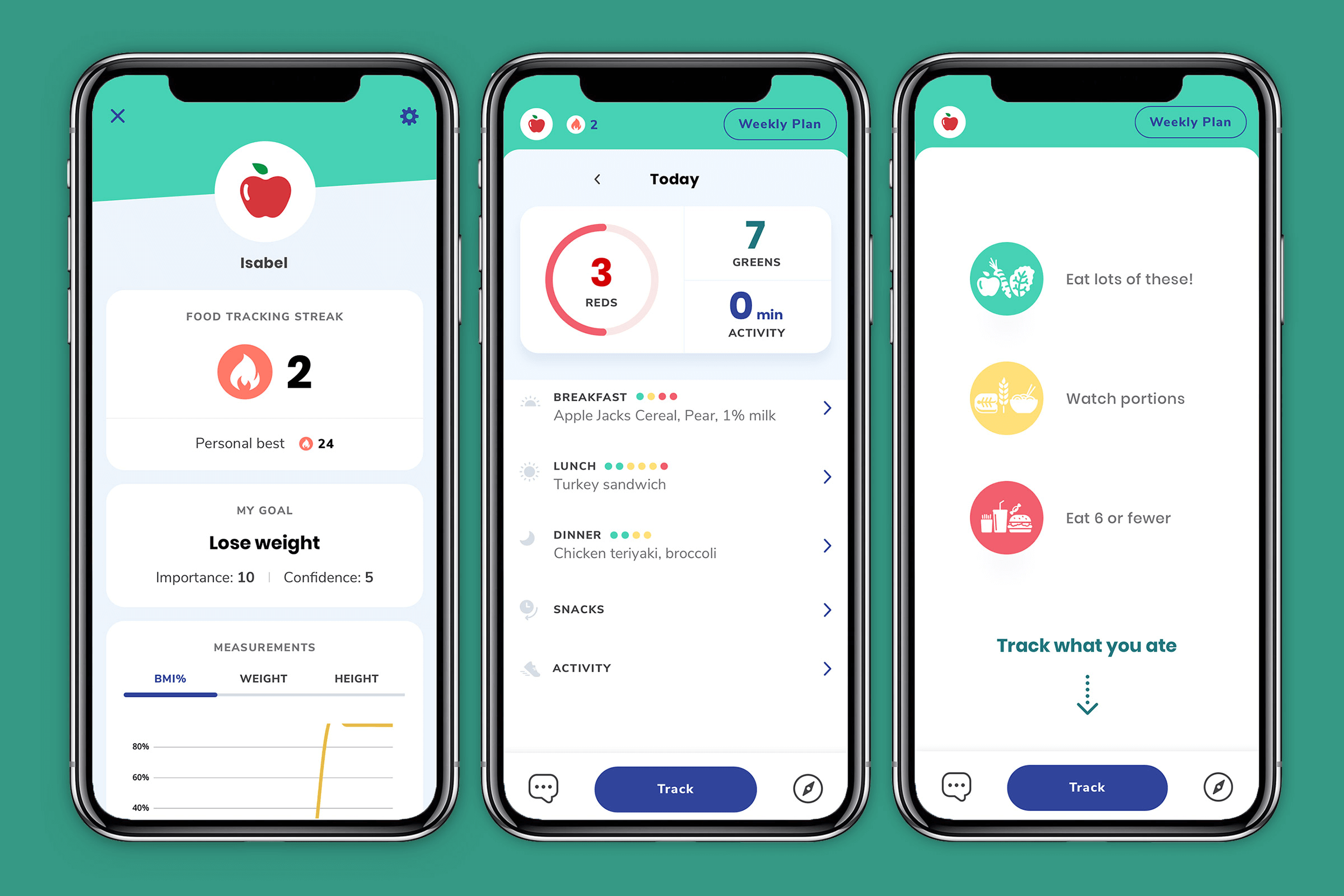
Tip for you – Using automatic algorithms is an excellent way to give personalized solutions. These algorithms collect, and analyze information from the user data such as age, weight, body parameters, etc., and then give recommendations.
In addition to this, you can include a live chat feature which will enable the user to chat with nutritionists and seek advice. The idea of professional consultation can also work as your USP.
Recipe Book
The diet application provides easy access to a book of healthy recipes, which helps Harry save a lot of time.
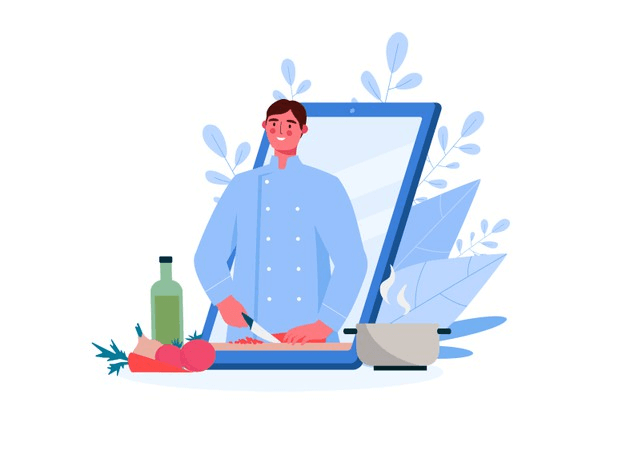
Tip for you – Go beyond offering a simple booklet. Make the recipe guide interesting with pictures or you can even implement voice instructions. Video tutorials are a good option too!
Shopping List
Another feature that Harry loves is the shopping list, which allows him to add groceries. Also, the app recommends products that match his diet plan.
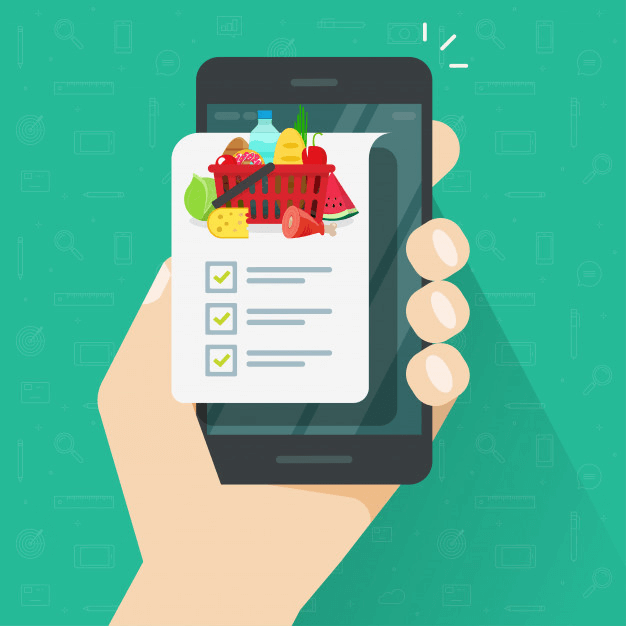
Tip for you – Make different features connected with one another. For instance, when users choose a recipe, they can automatically add the ingredients to the shopping list. This will help increase user satisfaction.
Blogs
The diet application offers dietary tips that Harry enjoys reading. It contains information about what to eat, how much to eat when to eat, and so on.
Tip for you – Your goal should be to provide engaging content. Blogs are an effective marketing strategy. If the user likes what they are reading they are likely to share further.
Gamification
Harry likes challenges. He believes that rewards give him a sense of competition and motivation to stay active. And the app luckily offers several gamification elements like points, badges, and ranks to reward him. This motivates him to actively use the diet app.
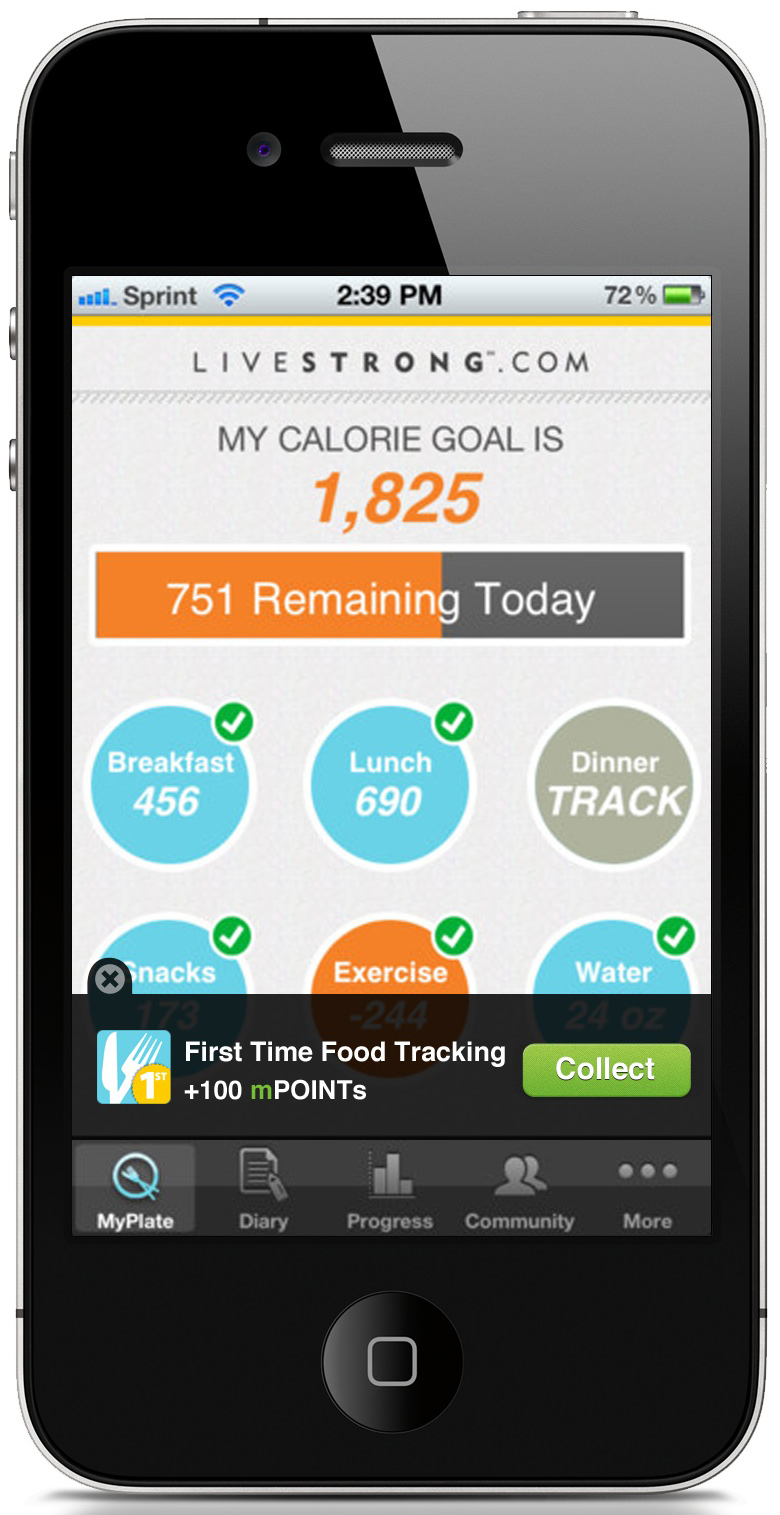
Tip for you – When working on this feature, offer some real benefits. For example, consultation with a nutritionist in exchange for earned points is a good way to leverage gamification.
Want to know more about the features?
Tech Tools to Build Diet & Nutrition App
Let’s have a closer look at the essential tools you need to build diet application
Fitness Data – Google Fit & HealthKit
Creating a personalized health experience includes –
- Collecting and storing fitness data
- Analyzing the data
- Enabling social interactions
Your nutrition guide app needs tools to collect customer data, based on which you can provide solutions. You have two options: Google Fit APIs for Android nutrition guide application or HealthKit for iOS nutrition app. With their help, you can gather health data in a single database.
iOS nutrition app: HealthKit, the default tool of the iOS platform aims to collect health-related information. Its basic functionalities are:
- Gather and store data
- Manage and merge data across different sources
- Enables social sharing
This tool kit guarantees the highest data security. It grants users control over the information that your app can share.
Android Nutrition Guide Application: Google Fit serves all Android platforms and gathers data on fitness activities. Here, Google’s privacy policy guarantees information protection. With the tool, you can get all the data you need, and exchange data. Google Fit includes –
- Sensors API for streaming raw sensor data
- Recording API to store fitness data through subscriptions
- History API helps you access the fitness history
- Goals API for tracking user goals
- Bluetooth Low Energy API for finding available devices and storing their data
Looking For a Tech Partner?
Nutrition Data
Your diet application needs a food database that gives users nutrition details. There are different APIs for different cases. Here are some popular ones:
- Edamam includes 700,000+ products and 520,000 universal product codes (UPC). Other than food databases, Edamam offers nutrition analysis and recipe search APIs.
- InRFood creates an accurate nutrition database by collaborating with nutritionists and dietitians.
- USDA Food Composition Databases offers food reports which include nutritional values of foods and nutrient reports which include nutritional values for particular nutrients.
- Personal Remedies allows users to get information on different nutrients based on their food preferences, allergies, and medicines they take.
Wearables
Wearables communicate with the relevant mobile application to provide the user with the data. Consumer’s interest in wearable technology increased after the release of Apple Watch.
Today, wearable technology such as Apple watch band for working out, Apple watch nutrition apps, etc. are invading the fitness sector. In 2022, the number of wearable users is expected to reach 900 million active users. It is crucial for a diet app to be compatible with as many wearable devices as possible.
Fitbit, Jawbone Up, Garmin, Nike+, Misfit are the SDKs and APIs you need to consider if you are planning to integrate your diet application with wearables like Apple Watch.
Apple and Google also provide SDKs for wearables. There are operating systems such as watchOS for Apple Watch nutrition apps and Wear OS for smartwatches running Android.
AI to Automate Nutrition Planning
AI makes everything better. As people are becoming more health-conscious, the demand for tech-based solutions is rising as well. That’s why we see many start-ups leveraging predictive analysis, deep learning, AI, and other technologies to develop apps.
62% customers are willing to use AI to improve experience. AI in diet planning is going to enable a more personalized strategy for meal planning, and this way you can serve the users in the best possible manner.
How AI-based Nutrition guide apps work? – AI-based diet planning uses varied algorithms to prepare a weekly menu for you users. Personalized solutions are derived from personal health, and lifestyle data.
For instance, users of FitGenie receive custom daily nutrition targets based on their desired fitness goals. This is done by AI algorithms.
From personalized solutions to helping your business with marketing strategies, AI can be a gamechanger.
How Much Does It Cost to Build Diet & Nutrition App?
The pricing of diet applications is tricky. It depends on several factors such as:
- Type of application – web or mobile
- Type of mobile application – native, cross-platform, hybrid, etc.
- Main features and functionality
- Advanced features
- Tools and technology
- Testing necessity
We believe that a successful diet application can only be created after it passes through four stages of development mainly –
1. Pre-design
Here, we take your project’s elementary into a workable strategy. Even if you have a basic idea that you want to build an app that counts calories, we will together find out how to take that further. We make sure to consider the right strategies, tools, technologies to implement.
We begin with the research and analysis phase, where, after understanding your goals, our team will create an overall flow of the diet application. At the end of this phase, we present you with our recommendations, technical specifications – basically a complete roadmap for your project.
2. Design Stage
After finalizing the skeleton, we move onto the design phase. Here, we iterate upon the UI.UX design of the diet app by creating wireframes, prototypes, and prepare a blueprint for the developers. We finalize the design only after conducting testing.
By the end of this phase, you will have a complete UX wireframe which includes the design of all the screens of your nutrition guide.
3. Development
It’s our time to do the magic with advanced coding techniques. Following the agile methodology and security protocols, we will build the app. We know that a diet app includes sensitive customer data. So, security is our priority. Our developers focus on writing the most secure code for your app.
4. Quality Assurance
We believe that app testing is important to get a scalable and reliable app. After the development stage, we send the app to our QA team. They conduct automated testing to find out if there are any glitches. Developers collaborate with them to work on the recommendations from their side.
After they wave the green flag, we deliver the nutrition guide app to you on a pre-defined date.
To understand the necessary aspects and to get detailed rates of building a diet app, you can refer to the below table. With iOs it will take 466 hours and in Android 465 hours to have a fully functional app. If you have it custom made, you can get in touch with us and we will help you out!
| Features | API | Native: Android (in Hrs) | Native: iOS (in Hrs) | ||||
|---|---|---|---|---|---|---|---|
| Module Name | Design | Development | QA/UAT/PM | Design | Development | QA/UAT/PM | |
| Facebook/Google/ Phone Number Login and Forgot password | 8 | 4 | 14 | 8 | 4 | 16 | 7 |
| User profile | 10 | 4 | 8 | 3 | 4 | 8 | 3 |
| Left menu and navigation | 2 | 2 | 4 | 2 | 2 | 6 | 2 |
| Dashboard -carbs, fat, water intake, protein, calories | 8 | 4 | 8 | 2 | 4 | 8 | 2 |
| Push Notification and notification hub | 16 | 3 | 12 | 5 | 3 | 10 | 5 |
| Diet Plan – Breakfast/Brunch, Lunch, Snacks, Dinner, Detox | 18 | 8 | 24 | 9 | 8 | 24 | 9 |
| Activity Planner – Today | 12 | 4 | 12 | 5 | 4 | 12 | 5 |
| Weekly Plan | 16 | 4 | 16 | 6 | 4 | 16 | 6 |
| Tip on each section | 6 | 2 | 12 | 2 | 2 | 12 | 2 |
| Recipe Book – Range of provided diet recipe | 8 | 4 | 12 | 6 | 4 | 12 | 6 |
| Shopping List, ready for shopping | 8 | 4 | 16 | 3 | 4 | 16 | 3 |
| Blogs | 8 | 3 | 8 | 2 | 3 | 8 | 2 |
| Gamification | 12 | 12 | 24 | 8 | 12 | 24 | 8 |
| Wearable device integration – Smart Watch, Smart Band | 8 | 0 | 30 | 6 | 0 | 30 | 6 |
| 140 | 58 | 200 | 67 | 58 | 202 | 66 | |
| Total | Native: Android + API | 465 | Native: iOS + API | 466 | |||
Make Profit with Nutrition Guide App
In September 2020, Calorie Counter generated over 1.44 million U.S. dollars in revenues from Android users. Fitbit was the second most successful app with 1.43 million U.S. dollars in revenues.
How did this happen? There are some monetization strategies these apps follow to earn. This is important for you too because, after all that you have spent to develop your app, you ought to earn from it.
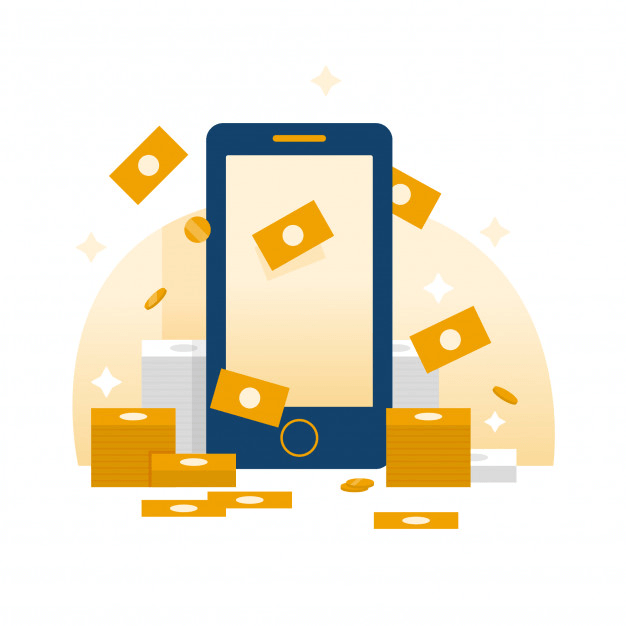
Here are some common strategies that you can use –
1. Freemium
If you want to create a powerful user base in less time, then freemium is one of the best ways. With this model, you attract users with basic features and then persuade them to switch to premium to get more.
If you go with this option, then you have to provide two functionality- (a) standard features that require no payment, (b) advanced and more helpful features. There are three ways to integrate the freemium model, which are as follows –
- Allow users to pay for each advanced feature.
- Users can sign a subscription plan to get additional features.
- You set up your virtual currency, which users will buy to unlock advanced functionalities.
Here, you need to maintain a balance between default and advanced features. If your app lacks certain basic features, users will switch to other apps. On the other hand, if the basic functions are too advanced, why would the user pay to get additional benefits?
2. In-app Advertising
In-app ads are a frequently used model to earn revenue from diet applications. Here, your source of income is from the advertisements (for example, ads that promote food supplements, sportswear, etc.) you display in the app.
In-app ads are a frequently used model to earn revenue from diet applications. Here, your source of income is from the advertisements (for example, ads that promote food supplements, sportswear, etc.) you display in the app.
3. Paid Apps
Users must pay to access Android or iOS diet applications. Simple!
If you are planning to make your diet application fully commercial, make sure to offer a free trial. Users are investing in your app, so they need to make sure it is worth it. The trial could be of different durations like a week, 15 days, or a month.
Another thing you need to know – the success of this model lies in your ability to present the most killer feature of your app in the Apple/Play store. Diet apps following this model (for example, My Diet Coach) are one of the best apps – packed with features like virtual rewards, barcode scanners, personalized diet plans, in-app graphs, and more.
4. Sponsorship
If you consider yourself an excellent salesperson, then you can try this monetization model. Here, the sponsor/advertiser you partner with encourages users to perform specific actions; let’s say, drink a certain amount of water every day. If they fulfill the condition, they receive a reward, and as an owner, you get a commission. Because of the gamification factor, users will get a reason to use your app more and more.
Over to You
The truth is that the stay-at-home situation is going to stay for some time. You cannot have an attitude – ‘I will resume when things get normal’. You have two options: adapt or see your fitness business die.
Hopefully, these tips for creating a nutrition guide app will allow you to carry on with your business and get a significant flow of money. If you think you cannot cope on your own, our team is happy to help. Do not hesitate to contact us if you have any questions.
Stay healthy, stay fit!
